Appropriate Use of Lime in the Study of the Physicochemical Behaviour of Stabilised Lateritic Soil under Continuous Water Ingress
Abstract
:1. Introduction
Significance and Novelty of This Research
2. Materials and Methods
2.1. Materials
2.2. Methods
2.2.1. Determination of Optimum Lime Content (OLC)
2.2.2. Geotechnical Tests
2.2.3. Column Leaching Tests and Physicochemical Analyses
3. Results
3.1. Effect of Lime on Soil Plasticity
3.2. Compaction
3.3. California Bearing Ratio and Strength Reduction Index
3.4. pH
3.5. Electrical Conductivity
3.6. Calcium and Potassium Concentrations
- Step 1:
- Hydration of quicklime to form calcium hydroxide:
- Step 2:
- Dissolution of calcium hydroxide to release and ions:
- Step 3:
- Formation of C-S-H and C-A-H via pozzolanic reactions:
3.7. Microstructural Analysis (Scanning Electron Microscopy)
3.8. X-ray Diffraction Analysis
4. Discussion
4.1. Influence of Water Ingress on the Durability of the Lime-Stabilised Lateritic Soil
4.2. Practical Engineering Implications
5. Conclusions
- Significant improvements in the workability of the LLS samples were obtained by treating the lateritic soil with lime in quantities that were above the soil’s OLC of 4%. For instance, the addition of 5 wt.% lime to the lateritic soil resulted in an optimum reduction of the plasticity index of the soil (PI = 5%). However, further increase in lime content above 5 wt.% caused both the soil’s liquid limit and plastic limit to increase with a corresponding increase in lime content. This behaviour, which is commonly observed in silica-rich residual soils, has been attributed to the high amount of C-S-H gel produced by the reaction of lime with silica. Consequently, the C-S-H gel adversely affects the plasticity index of the soil due to its high affinity for water.
- CBR test results showed substantial improvements in the engineering properties of the LLS samples as the soaking time increased from 3 to 28 days. This improvement were ascribed to the slow pozzolanic reactions that produced cementitious gels responsible for binding the soil particles together, except for the LLS sample treated with 5 wt.% which showed a substantial decrease in CBR after attaining a peak value of 47.1% after a soaking period of seven days.
- The EC values of the LLS samples showed a positive correlation with lime but generally decreased as the leaching time increased from three to 28 days. Similarly, pH values obtained from the leachate of the LLS samples decreased with an increase in leaching time but increased as lime increased from 0 to 20 wt.%. The leachate of the LLS samples were all above 12.0 (pH ≥ 12.0) at the end of a leaching period of 28 days, except for the LLS sample treated with 2.5 wt.% lime which had a pH of 10.8 at the end of the same leaching period.
- The durability and engineering properties of the LLS samples are closely related to their respective EC and pH values. Hence, the dissolution of the octahedral and tetrahedral sheets from the aluminosilicate constituents of the clay minerals, which occurs at higher EC and pH values, favours pozzolanic reactions that produce hydrated cementitious products responsible for improving the strength and stiffness of the lime-stabilised soil.
- Leaching tests conducted on the LLS samples showed that calcium and potassium concentrations increased with an increase in lime but decreased as leaching time increased from 3 to 28 days. Furthermore, minimum and maximum cation concentrations were observed at lime contents below and above the OLC of the soil.
- Results obtained from SEM and XRD analyses revealed that lime addition made the microfabric of the LLS samples to be very heterogeneous and aggregated, with a well-cemented morphology that signifies improvements in strength and stiffness of the soil mixtures. Similarly, the decrease in the peak intensities of chlorite, kaolinite and quartz was attributed to cation exchange and pozzolanic reactions.
- The LLS samples treated with 2.5 and 5 wt.% lime are not suitable for use as subgrade material because leaching caused adverse changes in their engineering properties, irrespective of the fact that the 5 wt.% LLS sample was treated with lime slightly above the soil’s OLC. This is because the amount of lime added to the soil mixtures was significantly below the LSO of the natural soil. Consequently, the leaching of calcium from the LLS samples could be related to the increase in the permeability of the soil as a result of the predominant effect of cation exchange and flocculation-agglomeration reactions. In contrast, leaching did not cause any obvious change in the durability of the LLS samples treated with 7.5 and 10 wt.% lime due to the high concentration of calcium that enhanced pozzolanic reactions.
- The adverse effect of lime on the strength and stiffness of the LLS samples treated with 15 and 20 wt.% lime tends to decrease with an increase in leaching time. This behaviour is strongly linked to the leaching of the viscous C-S-H gel and other water-holding gelatinous compounds formed as a result of the mid- to long-term pozzolanic reactions. Therefore, extensive leaching has the potential to decrease the high volume of gel water adsorbed between the solid particles of the hydration products thereby leading to a reduction in the liquid limit, and subsequent increase in strength and stiffness of the LLS samples.
Author Contributions
Funding
Institutional Review Board Statement
Informed Consent Statement
Data Availability Statement
Acknowledgments
Conflicts of Interest
References
- Abam, T.K.S.; Osadebe, C.C.; Omange, G.N. Influence of geology on pavement performance: A case study of Shagamu-Benin City Road, southwestern Nigeria. Glob. J. Geol. Sci. 2005, 3, 17–24. [Google Scholar] [CrossRef] [Green Version]
- Charlier, R.; Hornych, P.; Sršen, M.; Hermansson, Å.; Bjarnason, G.; Erlingsson, S.; Pavšič, P. Water influence on bearing capacity and pavement performance: Field observations. In Water in Road Structures; Springer: Dordrecht, The Netherlands, 2009; pp. 175–192. [Google Scholar] [CrossRef]
- Daniel, J.S.; Jacobs, J.M.; Douglas, E.; Mallick, R.B.; Hayhoe, K. Impact of climate change on pavement performance: Preliminary lessons learned through the infrastructure and climate network (ICNet). In Climatic Effects on Pavement and Geotechnical Infrastructure; American Society of Civil Engineers: Reston, VA, USA, 2014; pp. 1–9. [Google Scholar] [CrossRef] [Green Version]
- Elshaer, M.; Daniel, J.S. Impact of pavement layer properties on the structural performance of inundated flexible pavements. Transp. Geotech. 2018, 16, 11–20. [Google Scholar] [CrossRef]
- Bhuyan, H.; Scheuermann, A.; Bodin, D.; Becker, R. Soil moisture and density monitoring methodology using TDR measurements. Int. J. Pavement Eng. 2018, 21, 1–12. [Google Scholar] [CrossRef]
- Stoner, A.M.; Daniel, J.S.; Jacobs, J.M.; Hayhoe, K.; Scott-Fleming, I. Quantifying the impact of climate change on flexible pavement performance and lifetime in the United States. Transp. Res. Rec. 2019, 2673, 110–122. [Google Scholar] [CrossRef]
- Qiao, Y.; Santos, J.; Stoner, A.M.; Flinstch, G. Climate change impacts on asphalt road pavement construction and maintenance: An economic life cycle assessment of adaptation measures in the State of Virginia, United States. J. Ind. Ecol. 2020, 24, 342–355. [Google Scholar] [CrossRef]
- Montoya-Alcaraz, M.; Mungaray-Moctezuma, A.; García, L. Sustainable Road Maintenance Planning in Developing Countries Based on Pavement Management Systems: Case Study in Baja California, México. Sustainability 2020, 12, 36. [Google Scholar] [CrossRef] [Green Version]
- Huber, S.; Henzinger, C.; Heyer, D. Influence of water and frost on the performance of natural and recycled materials used in unpaved roads and road shoulders. Transp. Geotech. 2020, 100305. [Google Scholar] [CrossRef]
- Hasnayn, M.M.; McCarter, W.J.; Woodward, P.K.; Connolly, D.P. Railway subgrade performance after repeated flooding–Large-scale laboratory testing. Transp. Geotech. 2020, 23, 100329. [Google Scholar] [CrossRef]
- Camacho-Garita, E.; Aguiar-Moya, J.P.; Ávila-Esquivel, T.; Loría-Salazar, L.G. Effect of Moisture on Full-Scale Pavement Distress. J. Test. Eval. 2020, 48, 235–246. [Google Scholar] [CrossRef]
- Goswami, R.K.; Mahanta, C. Leaching characteristics of residual lateritic soils stabilised with fly ash and lime for geotechnical applications. Waste Manag. 2007, 27, 466–481. [Google Scholar] [CrossRef]
- Gidigasu, M. Laterite Soil Engineering: Pedogenesis and Engineering Principles; Elsevier: Amsterdam, The Netherlands, 2012; Volume 9. [Google Scholar]
- Ghosh, S.; Guchhait, S.K. Geochemical Properties and Lateritization Processes. In Laterites of the Bengal Basin; Springer: Cham, Switzerland, 2020; pp. 83–94. [Google Scholar] [CrossRef]
- Sani, J.E.; Yohanna, P.; Chukwujama, I.A. Effect of rice husk ash admixed with treated sisal fibre on properties of lateritic soil as a road construction material. J. King Saud Univ. Eng. Sci. 2020, 32, 11–18. [Google Scholar] [CrossRef]
- Morin, W.J.; Todor, P.C. Laterite and lateritic soils and other problem soils of the tropics. In an Engineering Evaluation and Highway Design Study for United State Agency for lnternational Development; AID/csd 3682-1; Lyon Associates Inc.: Baltimore, MD, USA, 1975. [Google Scholar]
- De Carvalho, J.C.; de Rezende, L.R.; Cardoso, F.B.D.F.; de Fllucena, L.C.; Guimarães, R.C.; Valencia, Y.G. Tropical soils for highway construction: Peculiarities and considerations. Transp. Geotech. 2015, 5, 3–19. [Google Scholar] [CrossRef]
- Paige-Green, P.; Pinard, M.N.; Etterberg, F. A review of specifications for lateritic materials for low volume roads. Transp. Geotech. 2015, 5, 86–98. [Google Scholar] [CrossRef]
- Eyo, E.U.; Ng’ambi, S.; Abbey, S.J. Effect of intrinsic microscopic properties and suction on swell characteristics of compacted expansive clays. Transp. Geotech. 2019, 18, 124–131. [Google Scholar] [CrossRef]
- Madu, R.M. An investigation into the geotechnical and engineering properties of some laterites of Eastern Nigeria. Eng. Geol. 1977, 11, 101–125. [Google Scholar] [CrossRef]
- Ogbuagu, F.U.; Okeke, C.A.U. Geotechnical properties of lateritic soil from Nimo and Nteje areas of Anambra State, Southeastern Nigeria. IOP Conf. Ser. Mater. Sci. Eng. 2019, 640, 012078. [Google Scholar] [CrossRef]
- De Freitas, J.B.; de Rezende, L.R.; de FNGitirana, G., Jr. Prediction of the resilient modulus of two tropical subgrade soils considering unsaturated conditions. Eng. Geol. 2020, 270, 105580. [Google Scholar] [CrossRef]
- Ola, S.A. The potentials of lime stabilization of lateritic soils. Eng. Geol. 1977, 11, 305–317. [Google Scholar] [CrossRef]
- Akoto, B.K.A.; Singh, G. Some geotechnical properties of a lime-stabilized laterite containing a high proportion of aluminium oxide. Eng. Geol. 1981, 17, 185–199. [Google Scholar] [CrossRef]
- Osula, D.O. Lime modification of problem laterite. Eng. Geol. 1991, 30, 141–154. [Google Scholar] [CrossRef]
- Omotosho, O.; Eze-Uzomaka, O.J. Optimal stabilisation of deltaic laterite. J. South Afr. Inst. Civ. Eng. 2008, 50, 10–17. [Google Scholar]
- Millogo, Y.; Morel, J.C.; Traoré, K.; Ouedraogo, R. Microstructure, geotechnical and mechanical characteristics of quicklime-lateritic gravels mixtures used in road construction. Constr. Build. Mater. 2012, 26, 663–669. [Google Scholar] [CrossRef]
- Jha, A.K.; Sivapullaiah, P.V. Mechanism of improvement in the strength and volume change behavior of lime stabilized soil. Eng. Geol. 2015, 198, 53–64. [Google Scholar] [CrossRef]
- Abbey, S.J.; Eyo, E.U.; Oti, J.; Amakye, S.Y.; Ngambi, S. Mechanical Properties and Microstructure of Fibre-Reinforced Clay Blended with By-Product Cementitious Materials. Geosciences 2020, 10, 241. [Google Scholar] [CrossRef]
- Abbey, S.J.; Olubanwo, A.O.; Ngambi, S.; Eyo, E.U.; Adeleke, B. Effect of Organic Matter on Swell and Undrained Shear Strength of Treated Soils. J. Civ. Constr. Environ. Eng. 2019, 4, 48–58. [Google Scholar] [CrossRef]
- Abbey, S.J.; Eyo, E.U.; Ng’ambi, S. Swell and microstructural characteristics of high-plasticity clay blended with cement. Bull. Eng. Geol. Environ. 2019, 79, 2119–2130. [Google Scholar] [CrossRef] [Green Version]
- Eyo, E.U.; Ngambi, S.; Abbey, S.J. Investigative study of behaviour of treated expansive soil using empirical correlations. In Proceedings of the International Foundation Congress and Equipment Expo, Orlando, FL, USA, 5–10 March 2018; pp. 373–384. [Google Scholar]
- Boardman, D.I.; Glendinning, S.; Rogers, C.D.F. Development of stabilisation and solidification in lime–clay mixes. Geotechnique 2001, 51, 533–543. [Google Scholar] [CrossRef]
- Rao, S.M.; Shivananda, P. Role of curing temperature in progress of lime-soil reactions. Geotech. Geol. Eng. 2005, 23, 79. [Google Scholar] [CrossRef]
- Aldaood, A.; Bouasker, M.; Al-Mukhtar, M. Effect of long-term soaking and leaching on the behaviour of lime-stabilised gypseous soil. Int. J. Pavement Eng. 2015, 16, 11–26. [Google Scholar] [CrossRef]
- Hilt, G.H.; Davidson, D.T. Lime Fixation in Clayey Soils. In Highway Research Board Bulletin; National Academy of Sciences: Washington, DC, USA, 1960; Available online: https://trid.trb.org/view/122475 (accessed on 10 October 2020).
- Diamond, S.; Kinter, E.B. Mechanisms of soil-lime stabilization. Highw. Res. Rec. 1965, 92, 83–102. Available online: https://onlinepubs.trb.org/onlinepubs/hrr/1965/92/92-006.pdf (accessed on 10 October 2020).
- Eades, J.L.; Grim, R.E. A Quick Test to Determine Lime Requirements for Lime Stabilization. In Highway Research Record 139; National Research Council: Washington, DC, USA, 1966; Available online: http://onlinepubs.trb.org/Onlinepubs/hrr/1966/139/139-005.pdf (accessed on 10 October 2020).
- Dash, S.K.; Hussain, M. Lime stabilization of soils: Reappraisal. J. Mater. Civ. Eng. 2011, 24, 707–714. [Google Scholar] [CrossRef]
- Cherian, C.; Arnepalli, D.N. A critical appraisal of the role of clay mineralogy in lime stabilization. Int. J. Geosynth. Ground Eng. 2015, 1, 8. [Google Scholar] [CrossRef] [Green Version]
- Eyo, E.U.; Ng’ambi, S.; Abbey, S.J. Performance of clay stabilized by cementitious materials and inclusion of zeolite/alkaline metals-based additive. Transp. Geotech. 2020, 23, 100330. [Google Scholar] [CrossRef]
- Eyo Ng’ambi, S.; Abbey, S.J. An overview of soil-water characteristic curves of stabilised soils and their influential factors. J. King Saud Univ. Eng. Sci. 2020, in press. [Google Scholar] [CrossRef]
- Eyo, E.U.; Ng’ambi, S.; Abbey, S.J. Incorporation of a nanotechnology-based additive in cementitious products for clay stabilisation. J. Rock Mech. Geotech. Eng. 2020, 12, 1056–1069. [Google Scholar] [CrossRef]
- Eyo, E.U.; Abbey, S.J.; Ngambi, S.; Ganjian, E.; Coakley, E. Incorporation of a nanotechnology-based product in cementitious binders for sustainable mitigation of sulphate-induced heaving of stabilised soils. Eng. Sci. Technol. Int. J. 2020, in press. [Google Scholar] [CrossRef]
- Oti, J.E.; Kinuthia, J.M. Lime stabilised glacial till clay incorporating wheat straw or waste tyre rubber granules. In Soil Stabilization: Types, Methods and Applications; Nova Science Publishers, Inc.: New York, NY, USA, 2017; pp. 339–353. [Google Scholar]
- Oti, J.E.; Kinuthia, J.M. The Development of Stabilised Clay-Hemp Building Material for Sustainability and Low Carbon Use. J. Civ. Eng. Constr. 2020, 9, 205–214. [Google Scholar] [CrossRef]
- Abbey, S.J.; Ngambi, S.; Olubanwo, A.O. Effect of overlap distance and chord angle on performance of overlapping soil-cement columns. Int. J. Civ. Eng. Technol. 2017, 8, 627–637. [Google Scholar]
- Eyo, E.U.; Ngambi, S.; Abbey, S.J. Investigative modelling of behaviour of expansive soils improved using soil mixing technique. Int. J. Appl. Eng. Res. 2017, 12, 3828–3836. [Google Scholar]
- Zhang, Y.; Johnson, A.E.; White, D.J. Freeze-thaw performance of cement and fly ash stabilized loess. Transp. Geotech. 2019, 21, 100279. [Google Scholar] [CrossRef]
- Hoyos, L.R.; Laikram, A.; Puppala, A.J. Assessment of seasonal effects on engineering behavior of chemically treated sulfate-rich expansive clay. In Expansive Soils—Recent Advances in Characterization and Treatment; CRC Press: Boca Raton, FL, USA, 2006; pp. 483–503. [Google Scholar]
- Consoli, N.C.; Carretta, M.S.; Leon, H.B.; Schneider, M.E.B.; Reginato, N.C.; Carraro, J.A.H. Behaviour of cement-stabilised silty sands subjected to harsh environmental conditions. Proc. Inst. Civ. Eng. Geotech. Eng. 2020, 1–9. [Google Scholar] [CrossRef]
- Le Runigo, B.; Cuisinier, O.; Cui, Y.J.; Ferber, V.; Deneele, D. Impact of initial state on the fabric and permeability of a lime-treated silt under long-term leaching. Can. Geotech. J. 2009, 46, 1243–1257. [Google Scholar] [CrossRef]
- Chittoori, B.C.; Puppala, A.J.; Wejrungsikul, T.; Hoyos, L.R. Experimental studies on stabilized clays at various leaching cycles. J. Geotech. Geoenviron. Eng. 2013, 139, 1665–1675. [Google Scholar] [CrossRef]
- Hunter, D. Lime-induced heave in sulfate-bearing clay soils. J. Geotech. Eng. 1988, 114, 150–167. [Google Scholar] [CrossRef]
- Obuzor, G.N.; Kinuthia, J.M.; Robinson, R.B. Soil stabilisation with lime-activated-GGBS—A mitigation to flooding effects on road structural layers/embankments constructed on floodplains. Eng. Geol. 2012, 151, 112–119. [Google Scholar] [CrossRef]
- Chittoori, B.C.; Mishra, D.; Islam, K.M. Forensic investigations into recurrent pavement heave from underlying expansive soil deposits. Transp. Res. Rec. 2018, 2672, 118–128. [Google Scholar] [CrossRef]
- Okeke, C.A.U.; Johnson, A.O.; Ogbuagu, F.U.; Akinmusuru, J.O. Effects of continuous leaching on engineering properties of lime-stabilized lateritic soils. IOP Conf. Ser. Mater. Sci. Eng. 2019, 640, 012084. [Google Scholar] [CrossRef] [Green Version]
- Okeke, C.A.U.; Ifediniru, C.; Adeyanju, E.; Ede, A.N. The stability analysis of a highway embankment founded on lime-stabilized soft soils in Calabar, Southeast Nigeria. IOP Conf. Ser. Mater. Sci. Eng. 2019, 640, 012103. [Google Scholar] [CrossRef]
- McCallister, L.D.; Petry, T.M. Physical property changes in a lime-treated expansive clay caused by leaching. Transp. Res. Rec. 1991, 1295. Available online: https://trid.trb.org/view/359113 (accessed on 12 October 2020).
- McCallister, L.D.; Petry, T.M. Leach tests on lime-treated clays. Geotech. Test. J. 1992, 15, 106–114. [Google Scholar] [CrossRef]
- Khattab, S.A.; Al-Mukhtar, M.; Fleureau, J.M. Long-term stability characteristics of a lime-treated plastic soil. J. Mater. Civ. Eng. 2007, 19, 358–366. [Google Scholar] [CrossRef]
- Le Runigo, B.; Ferber, V.; Cui, Y.J.; Cuisinier, O.; Deneele, D. Performance of lime-treated silty soil under long-term hydraulic conditions. Eng. Geol. 2011, 118, 20–28. [Google Scholar] [CrossRef] [Green Version]
- Deneele, D.; Le Runigo, B.; Cui, Y.J.; Cuisinier, O.; Ferber, V. Experimental assessment regarding leaching of lime-treated silt. Constr. Build. Mater. 2016, 112, 1032–1040. [Google Scholar] [CrossRef]
- Puppala, A.J. Advances in ground modification with chemical additives: From theory to practice. Transp. Geotech. 2016, 9, 123–138. [Google Scholar] [CrossRef]
- ASTM D6913/D6913M-17. Standard Test Methods for Particle-Size Distribution (Gradation) of Soils Using Sieve Analysis; ASTM International: West Conshohocken, PA, USA, 2017; Available online: https://www.astm.org/Standards/D6913 (accessed on 12 October 2020).
- ASTM D7928–17. Standard Test Method for Particle-Size Distribution (Gradation) of Fine-Grained Soils Using the Sedimentation (Hydrometer) Analysis; ASTM International: West Conshohocken, PA, USA, 2017; Available online: https://www.astm.org/Standards/D7928.htm (accessed on 12 October 2020).
- ASTM D6276-19. Standard Test Method for Using pH to Estimate the Soil-Lime Proportion Requirement for Soil Stabilization; ASTM International: West Conshohocken, PA, USA, 2019; Available online: https://www.astm.org/Standards/D6276.htm (accessed on 12 October 2020).
- Bell, F.G. Lime stabilization of clay minerals and soils. Eng. Geol. 1996, 42, 223–237. [Google Scholar] [CrossRef]
- ASTM D4318-17e1. Standard Test Methods for Liquid Limit, Plastic Limit, and Plasticity Index of Soils; ASTM International: West Conshohocken, PA, USA, 2017; Available online: https://www.astm.org/Standards/D4318.htm (accessed on 14 October 2020).
- ASTM D698-12e2. Standard Test Methods for Laboratory Compaction Characteristics of Soil Using Standard Effort (12,400 ft-lbf/ft3 (600 kN-m/m3)); ASTM International: West Conshohocken, PA, USA, 2012; Available online: https://www.astm.org/Standards/D698 (accessed on 14 October 2020).
- ASTM D1883-16. Standard Test Method for California Bearing Ratio (CBR) of Laboratory-Compacted Soils; ASTM International: West Conshohocken, PA, USA, 2016; Available online: https://www.astm.org/Standards/D1883 (accessed on 14 October 2020).
- Okeke CAU. Engineering behaviour of lime-and waste ceramic dust-stabilized expansive soil under continuous leaching. Bull. Eng. Geol. Environ. 2020, 79, 2169–2185. [Google Scholar] [CrossRef]
- Obuzor, G.N.; Kinuthia, J.M.; Robinson, R.B. Utilisation of lime activated GGBS to reduce the deleterious effect of flooding on stabilised road structural materials: A laboratory simulation. Eng. Geol. 2011, 122, 334–338. [Google Scholar] [CrossRef]
- Horpibulsuk, S.; Rachan, R.; Chinkulkijniwat, A.; Raksachon, Y.; Suddeepong, A. Analysis of strength development in cement-stabilized silty clay from microstructural considerations. Constr. Build. Mater. 2010, 24, 2011–2021. [Google Scholar] [CrossRef]
- Hossain, K.M.A.; Lachemi, M.; Easa, S. Stabilized soils for construction applications incorporating natural resources of Papua New Guinea. Resour. Conserv. Recycl. 2007, 51, 711–731. [Google Scholar] [CrossRef]
- Kinuthia, J.M.; Wild, S.; Jones, G.I. Effects of monovalent and divalent metal sulphates on consistency and compaction of lime-stabilised kaolinite. Appl. Clay Sci. 1999, 14, 27–45. [Google Scholar] [CrossRef]
- Anday, M.C. Curing Lime-Stabilized Soils. Natl. Res. Counc. Highw. Res. Rec. 1963, 29, 13–26. Available online: http://onlinepubs.trb.org/Onlinepubs/hrr/1963/29/29-002.pdf (accessed on 15 October 2020).
- Federal Ministry of Works and Housing. Federal Ministry of Works: Highway Manual (Part 1): Design. Pavement and Materials Design; Federal Ministry of Works and Housing: Abuja, Nigeria, 2013; Volume 3. [Google Scholar]
- Al-Mukhtar, M.; Khattab, S.; Alcover, J.F. Microstructure and geotechnical properties of lime-treated expansive clayey soil. Eng. Geol. 2012, 139, 17–27. [Google Scholar] [CrossRef]
- Ahmed, A.; Issa, U.H. Stability of soft clay soil stabilised with recycled gypsum in a wet environment. Soils Found. 2014, 54, 405–416. [Google Scholar] [CrossRef] [Green Version]
- Bhurtel, A.; Eisazadeh, A. Strength and Durability of Bottom Ash and Lime Stabilized Bangkok Clay. Ksce, J. Civ. Eng. 2020, 24, 404–411. [Google Scholar] [CrossRef]
- Maaitah, O.N. Soil stabilization by chemical agent. Geotech. Geol. Eng. 2012, 30, 1345–1356. [Google Scholar] [CrossRef]
- Saride, S.; Puppala, A.J.; Chikyala, S.R. Swell-shrink and strength behaviors of lime and cement stabilized expansive organic clays. Appl. Clay Sci. 2013, 85, 39–45. [Google Scholar] [CrossRef]
- Al-Mukhtar, M.; Lasledj, A.; Alcover, J.F. Behaviour and mineralogy changes in lime-treated expansive soil at 20 °C. Appl. Clay Sci. 2010, 50, 191–198. [Google Scholar] [CrossRef]
- Khadka, S.D.; Jayawickrama, P.W.; Senadheera, S.; Segvic, B. Stabilization of highly expansive soils containing sulfate using metakaolin and fly ash based geopolymer modified with lime and gypsum. Transp. Geotech. 2020, 23, 100327. [Google Scholar] [CrossRef]
- Sergeyev, Y.M.; Grabowska-Olszewska, B.; Osipov, V.I.; Sokolov, V.N.; Kolomenski, Y.N. The classification of microstructures of clay soils. J. Microsc. 1980, 120, 237–260. [Google Scholar] [CrossRef]
- Bhuvaneshwari, S.; Robinson, R.G.; Gandhi, S.R. Behaviour of lime treated cured expansive soil composites. Indian Geotech. J. 2014, 44, 278–293. [Google Scholar] [CrossRef]
- Ng, C.W.; Akinniyi, D.B.; Zhou, C.; Chiu, C.F. Comparisons of weathered lateritic, granitic and volcanic soils: Compressibility and shear strength. Eng. Geol. 2019, 249, 235–240. [Google Scholar] [CrossRef]
- Indraratna, B.; Nutalaya, P. Some engineering characteristics of a compacted lateritic residual soil. Geotech. Geol. Eng. 1991, 9, 125–137. [Google Scholar] [CrossRef]
- Kamtchueng, B.T.; Onana, V.L.; Fantong, W.Y.; Ueda, A.; Ntouala, R.F.; Wongolo, M.H.; Ndongo, G.B.; Ze, A.N.; Kamgang, V.K.; Ondoa, J.M. Geotechnical, chemical and mineralogical evaluation of lateritic soils in humid tropical area (Mfou, Central-Cameroon): Implications for road construction. Int. J. Geo-Eng. 2015, 6, 1. [Google Scholar] [CrossRef] [Green Version]
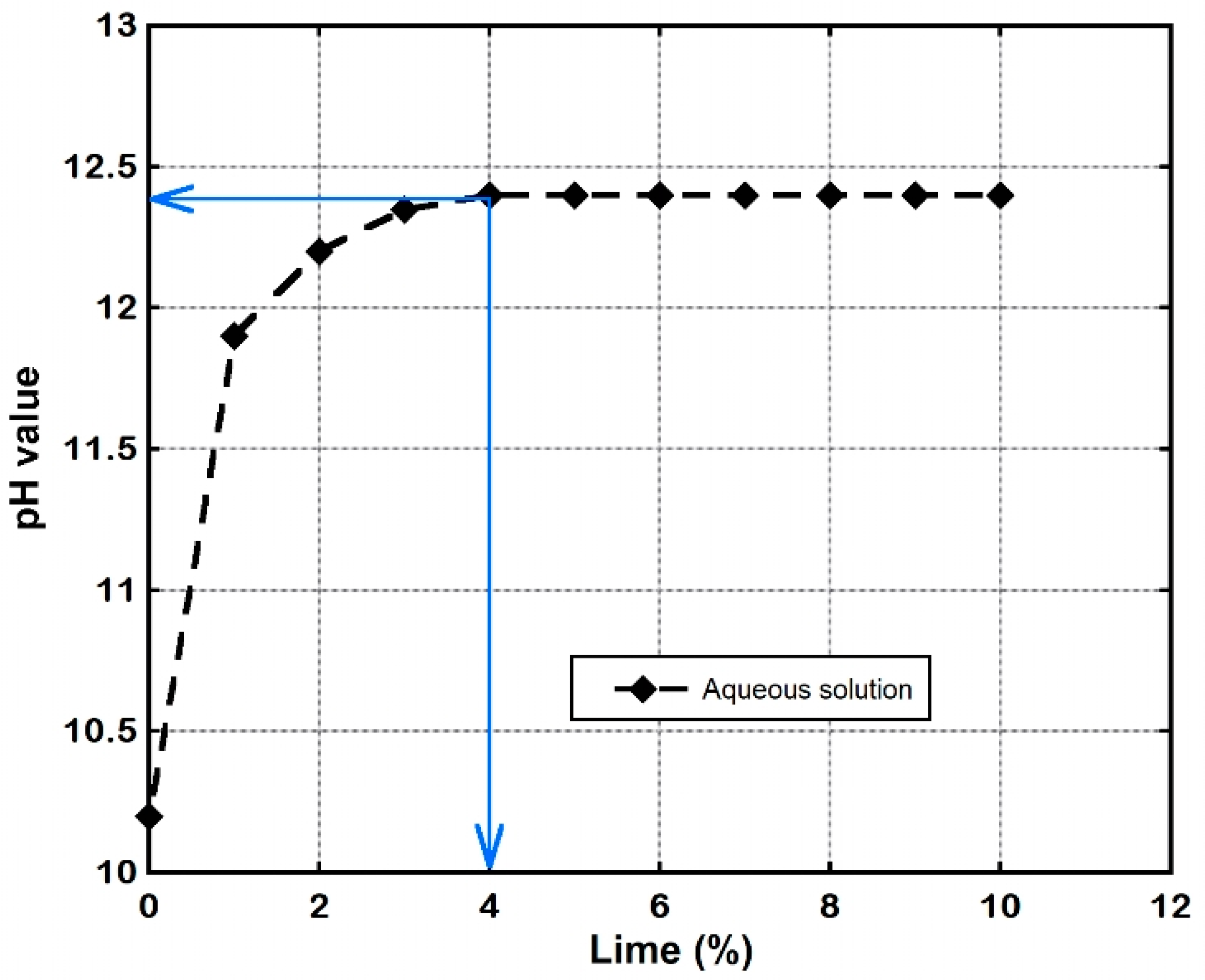
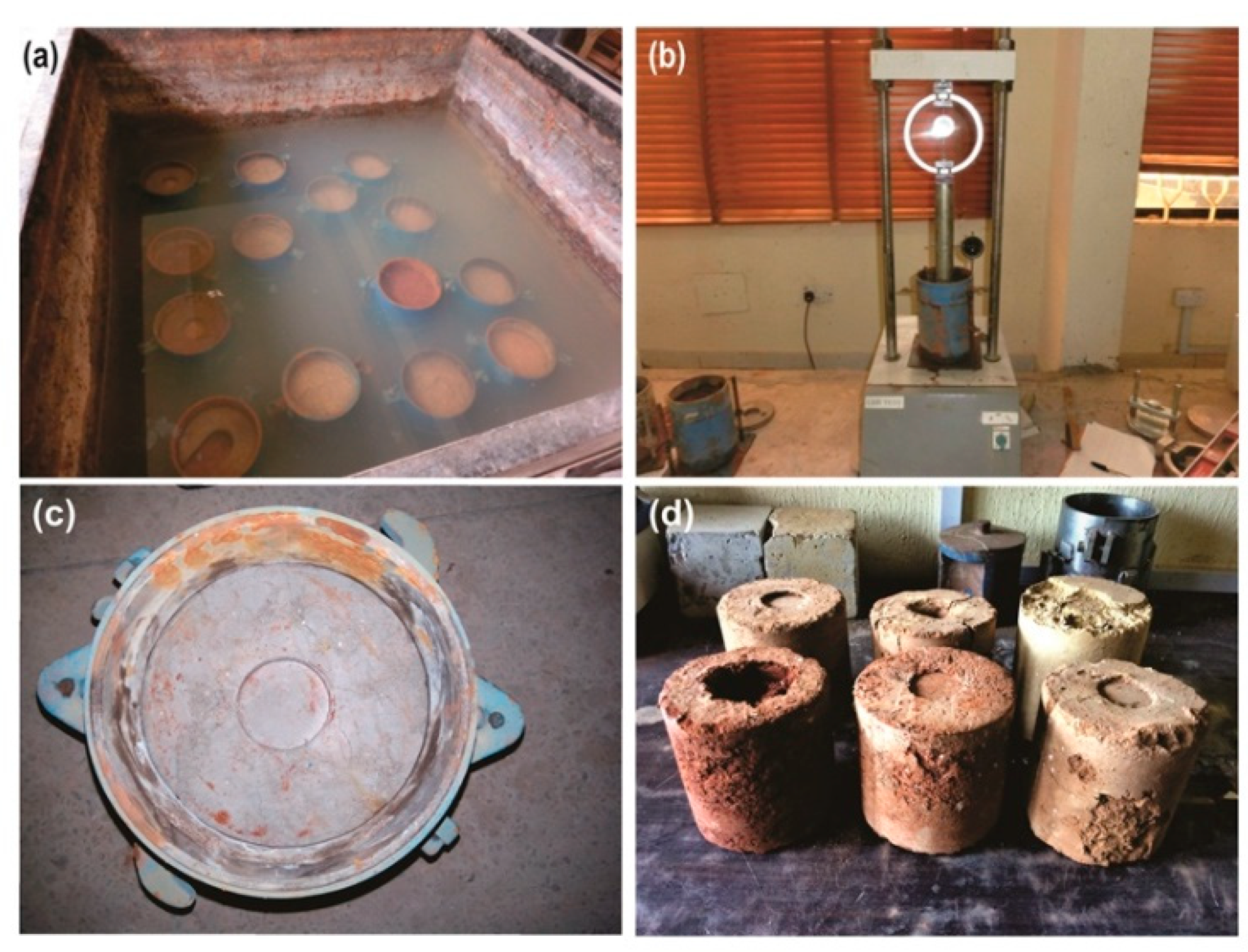


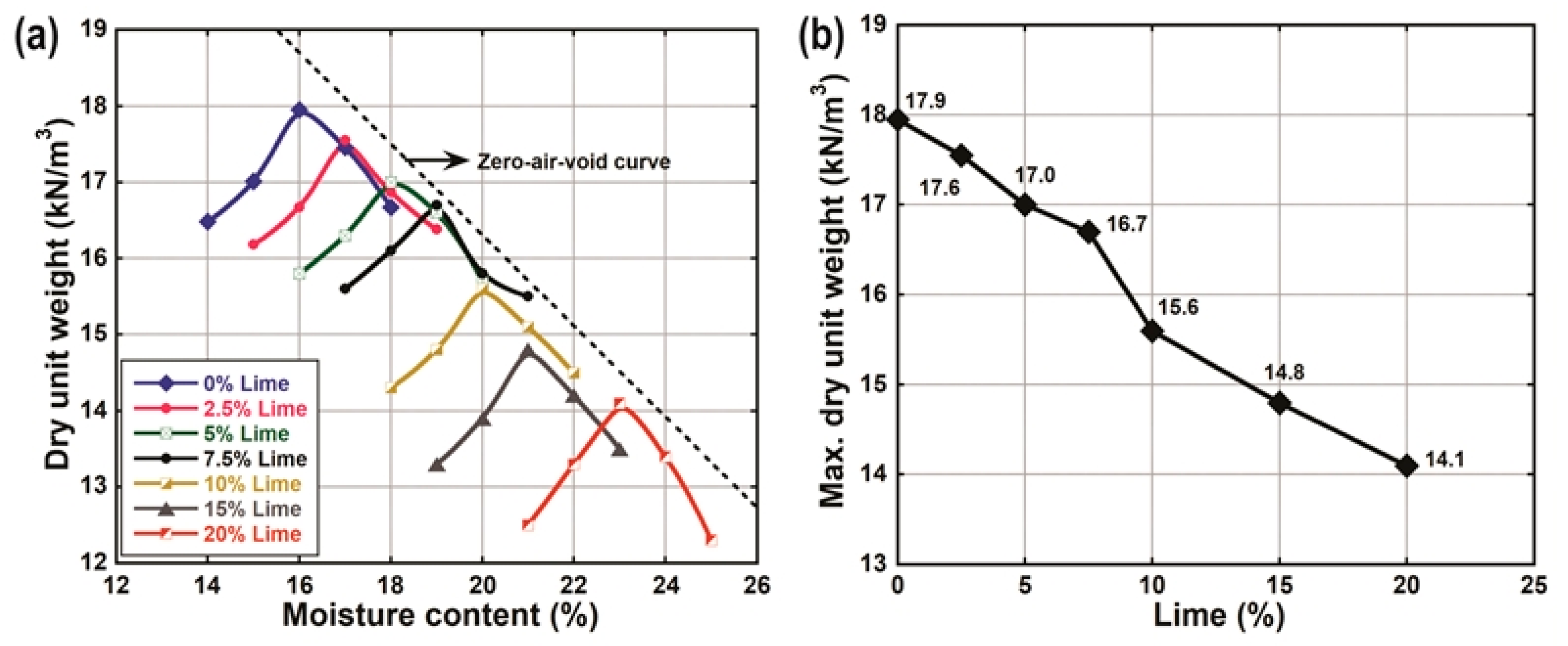
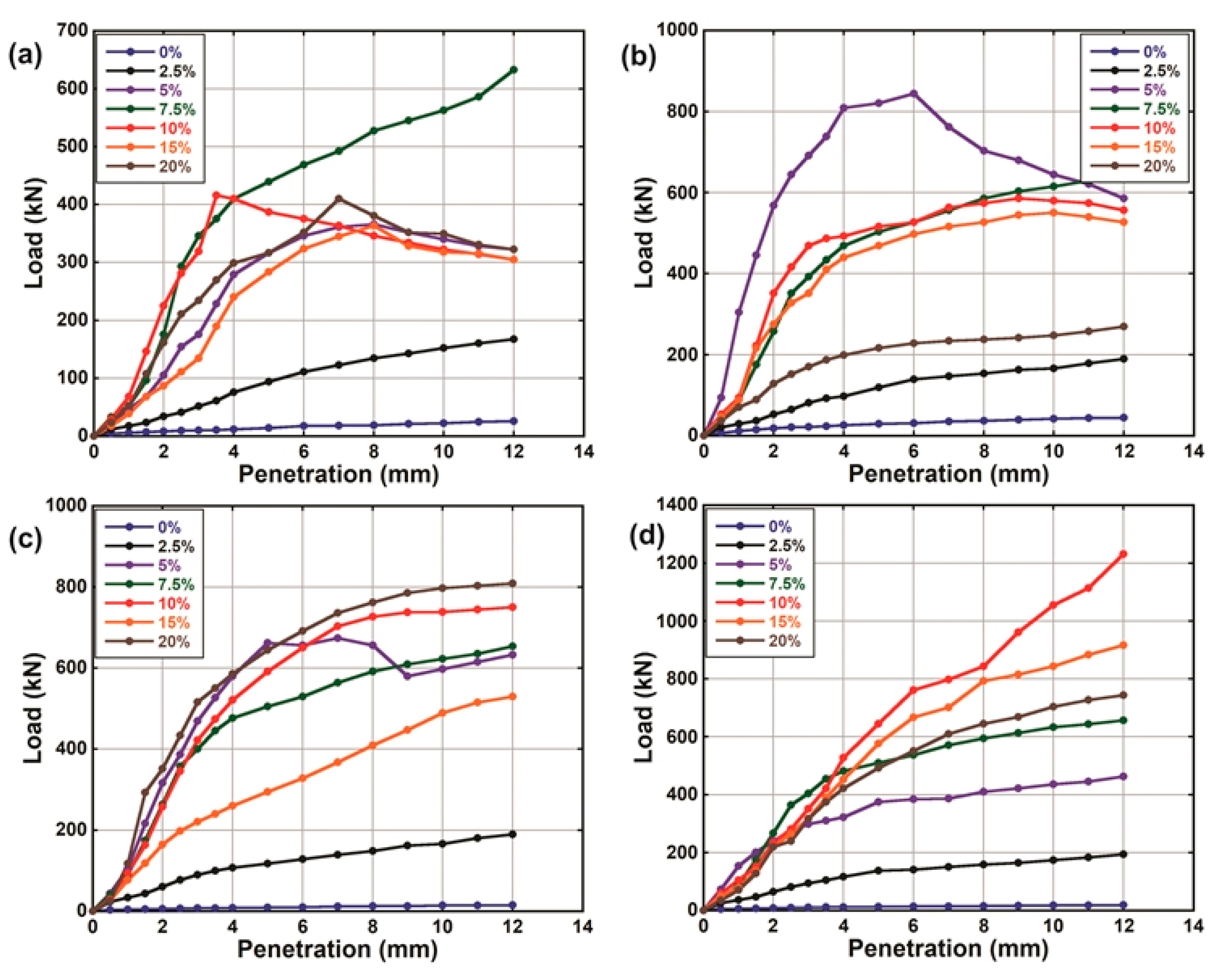
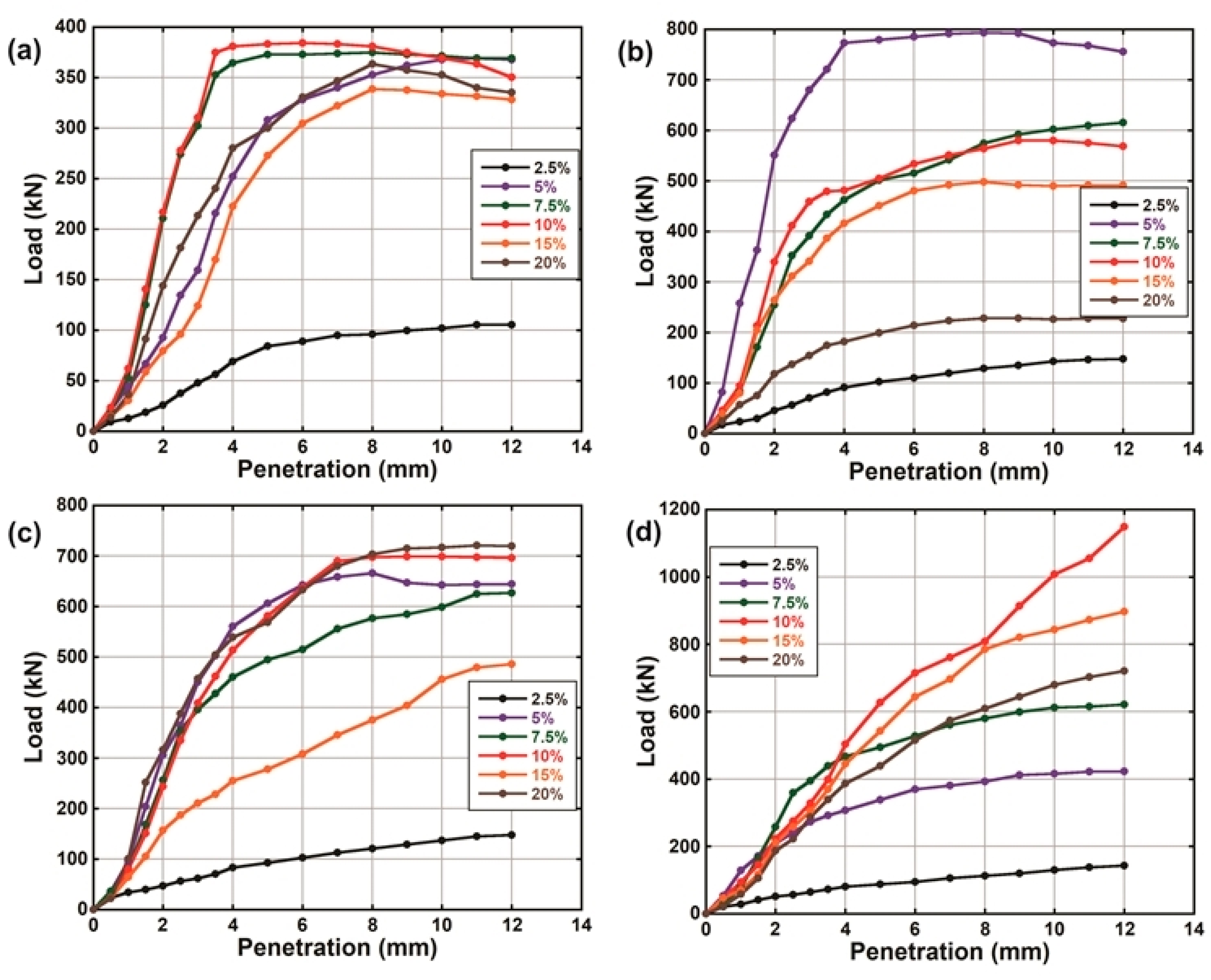
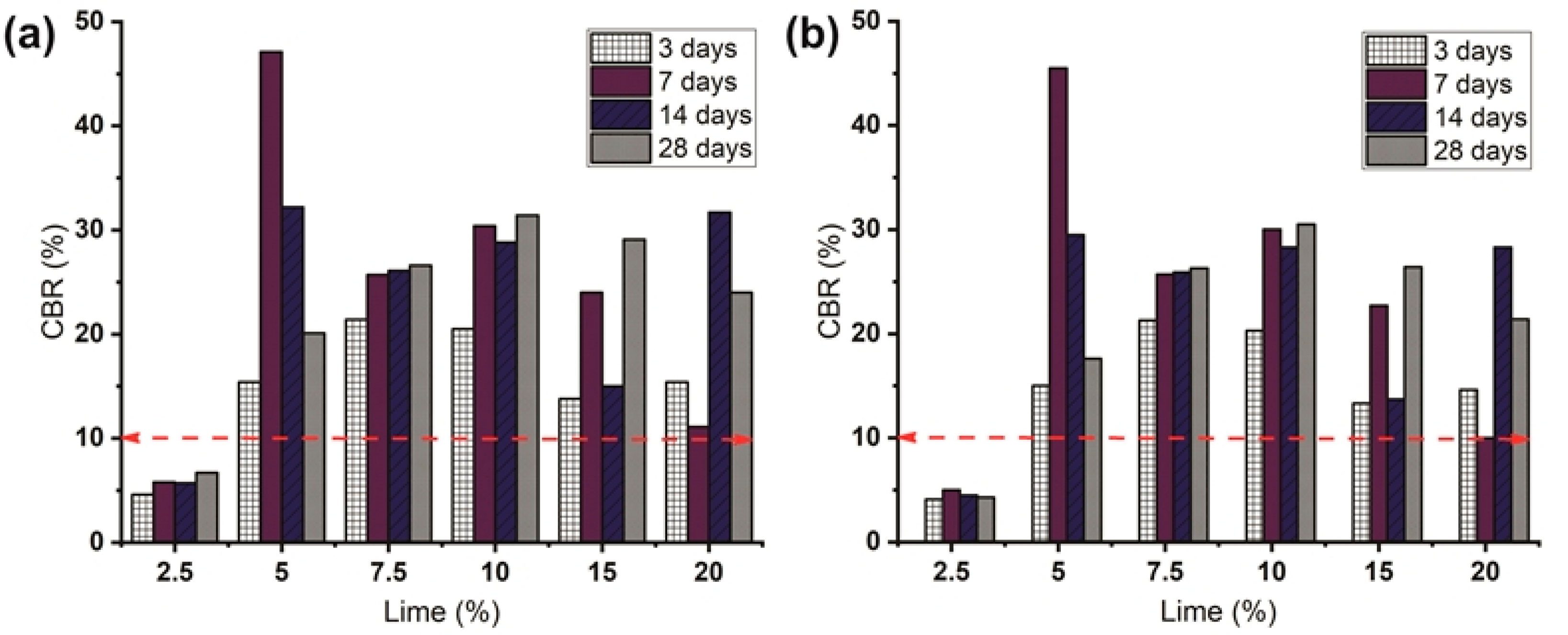

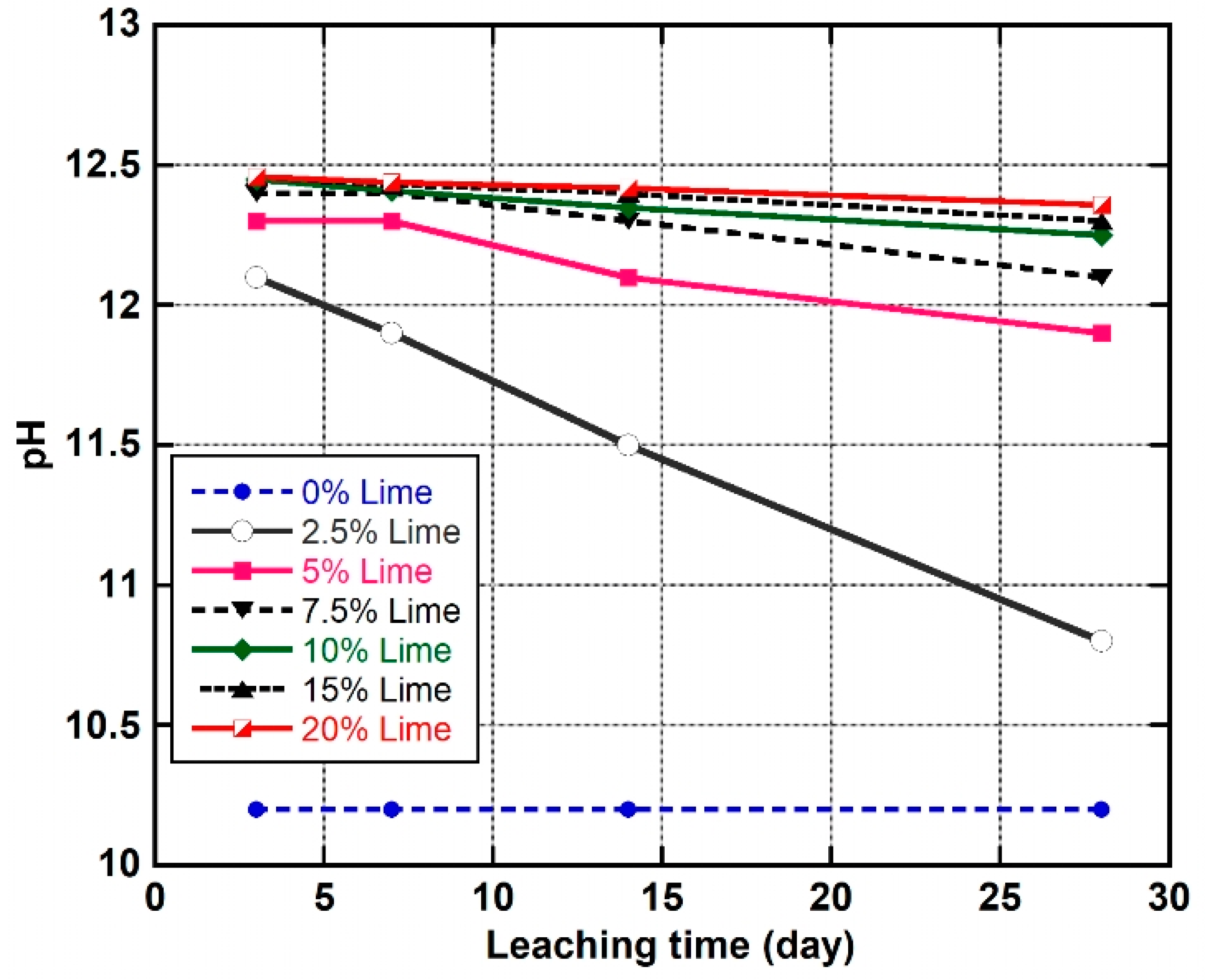

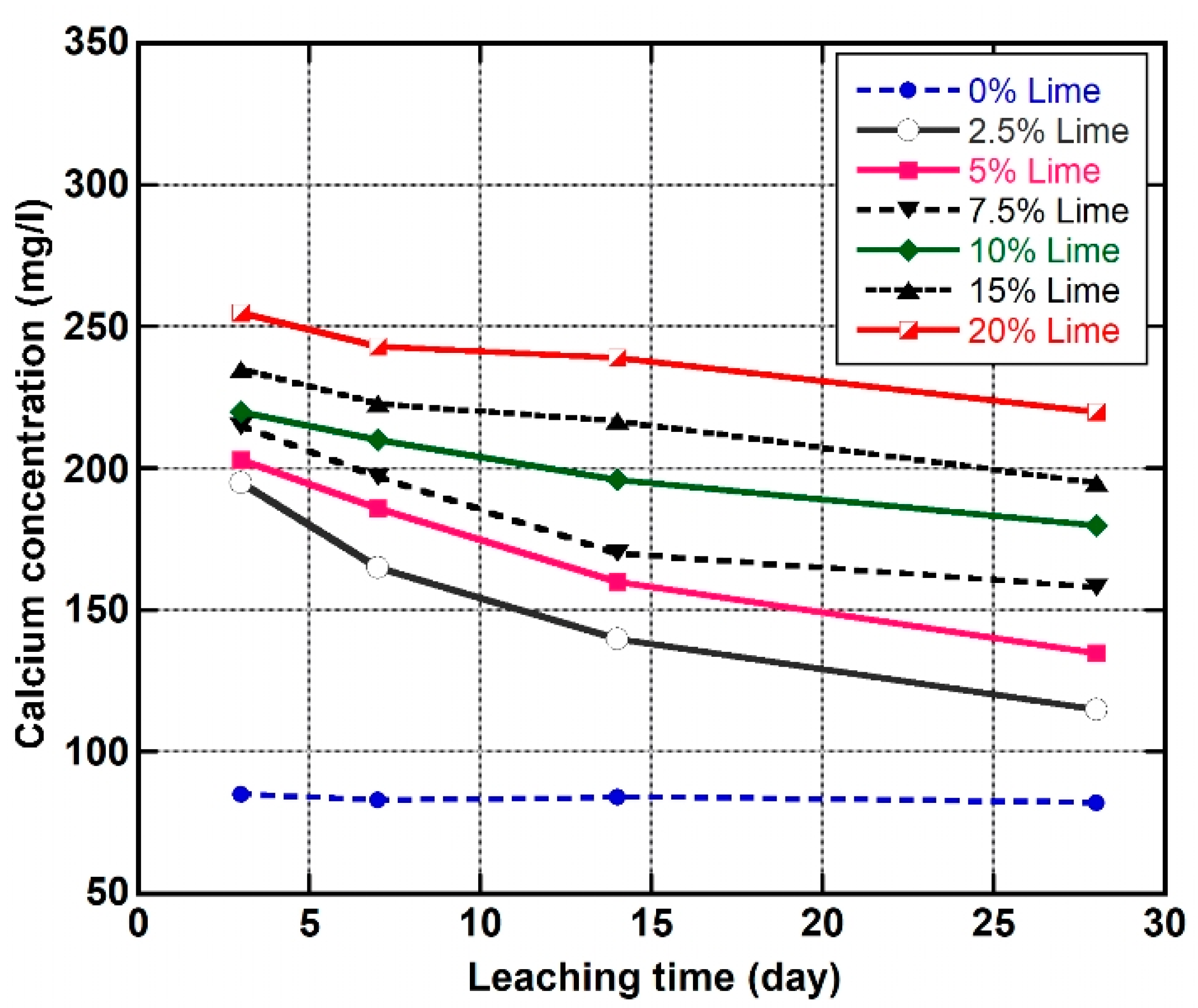
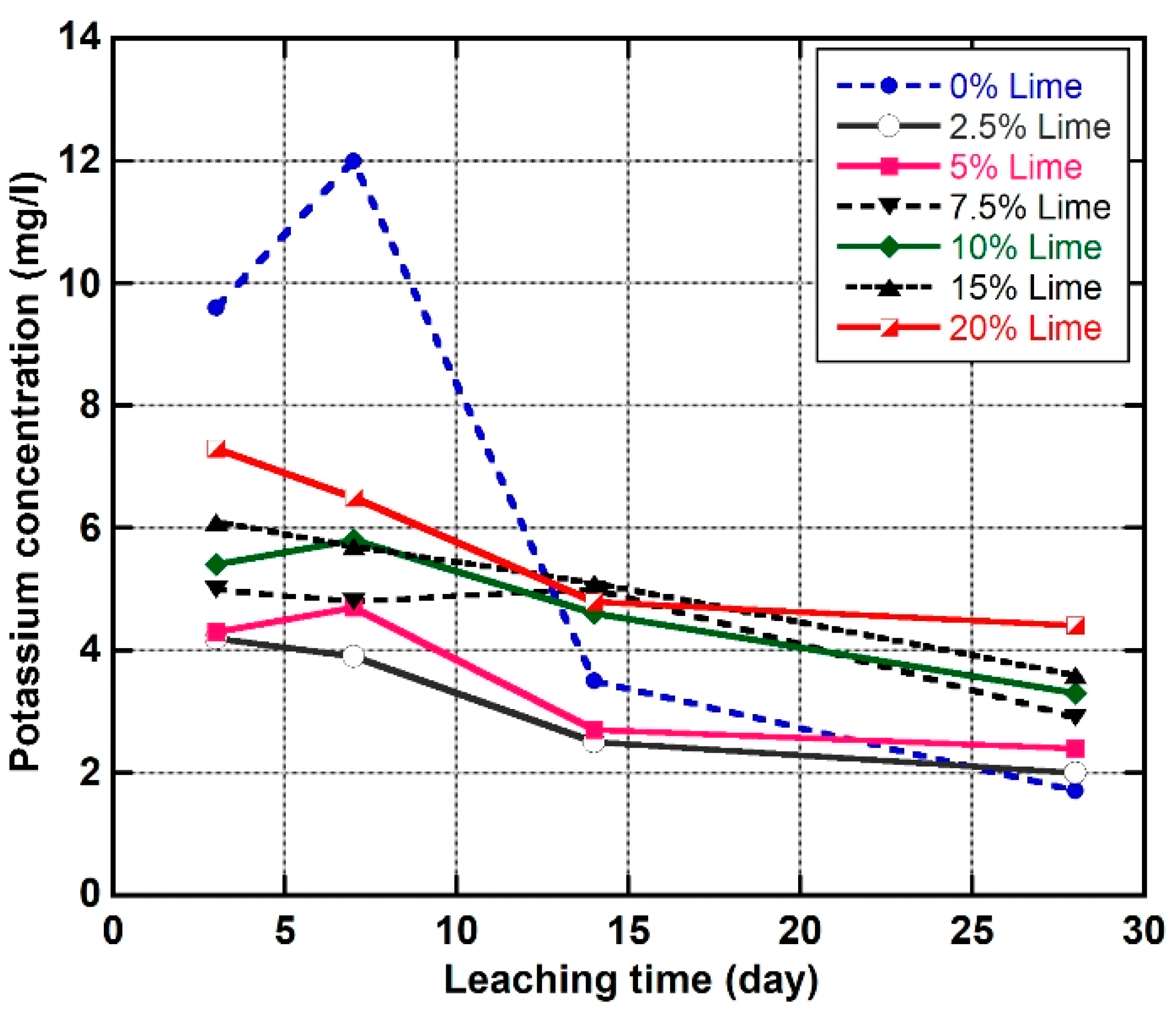


| Property | Value |
|---|---|
| Percent passing sieve No. 200 | 53 |
| Liquid limit (%) | 49 |
| Plastic limit (%) | 21 |
| Plasticity index (%) | 28 |
| AASHTO | A-7-6 |
| OMC (%) | 16 |
| MDD (kN/m3) | 17.95 |
| CBR (unsoaked) (%) | 5 |
| Material | Oxide Composition (wt.%) | ||||||||||||
|---|---|---|---|---|---|---|---|---|---|---|---|---|---|
| SiO2 | Al2O3 | Fe2O3 | TiO2 | K2O | ZrO2 | MgO | CaO | MnO | Mn2O3 | CuO | Na2O | LOI | |
| Lateritic soil | 53.56 | 11.62 | 23.45 | 1.31 | 0.98 | 0.04 | 0.53 | 0.03 | 0.09 | - | 0.02 | 0.18 | 7.44 |
| Lime | 1.0 | 0.3 | 0.5 | - | - | - | 2.0 | 94.0 | 1.2 | - | - | - | |
Publisher’s Note: MDPI stays neutral with regard to jurisdictional claims in published maps and institutional affiliations. |
© 2020 by the authors. Licensee MDPI, Basel, Switzerland. This article is an open access article distributed under the terms and conditions of the Creative Commons Attribution (CC BY) license (http://creativecommons.org/licenses/by/4.0/).
Share and Cite
Okeke, C.; Abbey, S.; Oti, J.; Eyo, E.; Johnson, A.; Ngambi, S.; Abam, T.; Ujile, M. Appropriate Use of Lime in the Study of the Physicochemical Behaviour of Stabilised Lateritic Soil under Continuous Water Ingress. Sustainability 2021, 13, 257. https://doi.org/10.3390/su13010257
Okeke C, Abbey S, Oti J, Eyo E, Johnson A, Ngambi S, Abam T, Ujile M. Appropriate Use of Lime in the Study of the Physicochemical Behaviour of Stabilised Lateritic Soil under Continuous Water Ingress. Sustainability. 2021; 13(1):257. https://doi.org/10.3390/su13010257
Chicago/Turabian StyleOkeke, Chukwueloka, Samuel Abbey, Jonathan Oti, Eyo Eyo, Abiola Johnson, Samson Ngambi, Tamunoene Abam, and Mgboawaji Ujile. 2021. "Appropriate Use of Lime in the Study of the Physicochemical Behaviour of Stabilised Lateritic Soil under Continuous Water Ingress" Sustainability 13, no. 1: 257. https://doi.org/10.3390/su13010257
APA StyleOkeke, C., Abbey, S., Oti, J., Eyo, E., Johnson, A., Ngambi, S., Abam, T., & Ujile, M. (2021). Appropriate Use of Lime in the Study of the Physicochemical Behaviour of Stabilised Lateritic Soil under Continuous Water Ingress. Sustainability, 13(1), 257. https://doi.org/10.3390/su13010257







